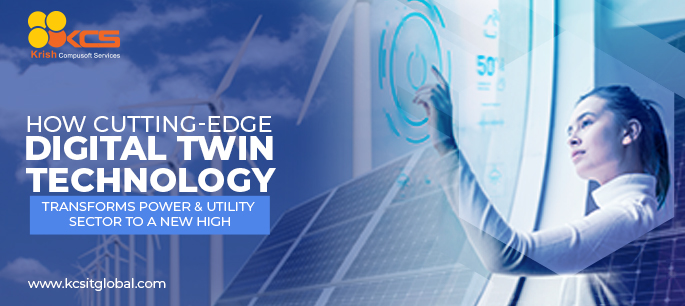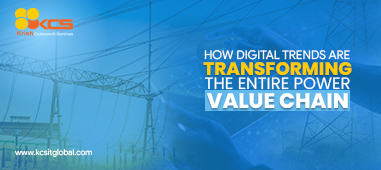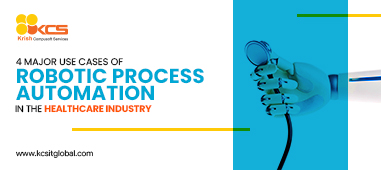
Category: Cloud, Data Engineering & Analytics, AI & Automation, Digital Transformation
How Cutting-Edge Digital Twin Technology Transforms Power and Utility Sector to a New High
The power and utility sectors are undergoing a major change in the form of various digital transformation initiatives to introduce digitalization and a lot of dynamism in this critical sector. Various efforts are going on in the power and utility sector to optimize and channelize the process of electricity generation in power plants so as to improve their operations, reduce the number of unplanned outages and give greater predictability in a majority of their processes. These solutions come in the form of managing the volatile and fluctuating market conditions, correctly handling the fuel costs and even correctly predicting and refining the weather patterns in order to improve the profitability of power plants.
However, it is no secret that before the advent of digital transformation initiatives, all such listed efforts were disjoined and these measures were not integrated in a single platform so as to bring a streamlined solution to all power plant processes. With the advent of the Industrial Internet of Things (IIoT) and the advanced working of the power plants, there is a wealth of data that is generated from each of the processes of the power plants and its implementation in the realm of Big Data, making use of advanced analytical techniques to predict the outcome and streamline the operations of the power plants.
It is in this context that digital twin technology should be looked at with a highly organized and holistic manner and controlled physics related methods and by incorporating advanced analytics which are used to model the present state of assets in a digital version of a power plant. In plain words, a digital twin is a digital representation of the physical model of various components along with various systems and subsystems of the processes taking place in the complex equipment of the power generation processes. Such kind of digital models map all the parameters of all the equipment and systems like the thermal, mechanical, fluid dynamics, electrical, chemical, along with materials, statistical and economic models.
The digital twins in power and utilities can be constructed at different stages of development of an entity, like the design phase, build phase, and operational phase. In the design phase, different conditions that the equipment in the power plant goes through are simulated and the power plant is designed accordingly, keeping in mind the behaviour of the digital twin of the plant in the design phase. For the build phase, the exact specifications that are required for every equipment, system and subsystem in the power plant are met, helping the designers and engineers to decide what should be included in the building process and how it is going to represent the entire system at the operational phase. The digital twin technology is also useful in the operational phase of the power plant, where with the help of sensors, the digital twin provides all relevant data about the physical state of the twin. This is highly useful for engineers in the operational and maintenance phases, as they take full control of the processes taking place and this becomes a reality due to the inclusion of latest computing technology, better telemetry, accurate and highly advanced sensors, big data management techniques and artificial intelligence.
In the preparation of these digital twin for electricity models, cutting edge technologies related to optimizing, forecasting, and control to map the flexibility, maintainability, availability and performance of different components in the power plants are carried out. In addition, digital twin models also give an accurate picture regarding the different combinations of variables that are operating in the power generation equipment and can be in the form of parameters like fuel mix, air quality, ambient temperature, moisture, and even weather patterns and market performance. Such kind of digital models are used along with the sensor technologies available with the Internet of Things (IoT) and help the power plant operators to predict the performance of the power plant under different scenarios and enhancing the efficiencies of all the different complex components and equipment in the power plant. In the digital twin technology, while a digital twin consumes data and output from the physical sensors placed, it also feeds data to the physical object. This bidirectional data relationship where digital and physical objects are paired together is known as virtual twinning. Such a system has immense business value which is discussed next in the article.
First and foremost, business value that is derived from electrical digital twinning is the capability of real time predictive analysis. Asset owners are equipped with real-time predictive analysis and information regarding various important parameters that impact all the critical equipment in a power plant is readily available with the managers/asset owners. With the help of digital twinning, downtime can be reduced by giving clear and actionable insights regarding predictive maintenance and efficiency optimization and this info is produced with the help of sensors that are installed in every critical piece of equipment functioning in a power generation plant like gas turbines, generation units, transmission units, etc. With the help of digital representation of physical equipment, asset owners can predict failures and also highlight the non-performance of assets. With the aid of digital twin models, expensive physical repairs of assets are avoided and reactive repairs are almost eliminated.
Also, digital twins in the energy sector prove to be of value in the realm of remote asset management and operators are in a position to visualize the performance of various assets under their control based on the correct simulation of their native environments with the help of digital twins and by applying different scenarios in various combinations, the exact behaviour of the system can be known and such virtual scenarios reduce the service costs. Such digital twin components are also used in training new engineers for a perfect performance in operating a power plant with various augmented/virtual reality technologies in tandem with digital twin technologies. In addition, physical proximity to the installed equipment (physical) is not required in this setting and this proves to be a blessing in situations where there is no easy accessibility in the power plants and in such cases, digital twins can be invaluable.
Also, as stated earlier, digital twins give a fillip to the research and innovation of various processes and systems that are operating in this value chain. With the help of digital representation and simulating the various scenarios with their digital representation in the predictive models helps in getting invaluable information about the workings of such complex systems. With the help of digital twin technology, the impact of changes in important parameters like design parameters, environmental parameters, and other important variables, thereby eliminating the need of a physical model. Such data points with the help of their digital representation helps to reduce costs and aid in the predictive analysis along with optimization of critical processes.
Digital twin technologies combined with cloud and machine learning technologies are proving to be of immense value to operation of facilities like that of the power plants. With the help of high-performance computing technologies like workstations based on cloud, simulation and predictive analysis along with deep learning and artificial intelligence, the digital twin technologies are able to make a game-changing difference in the functioning of the power plants and refine the power generation processes to a new level. With the help of latest high-performance computing, Internet of Things and mixed reality technologies, they are bringing in a new type of digital twin known as the process digital twin. Such kind of new class of digital twins utilize the latest technologies to usher in powerful and agile capabilities in the simulation models that also change the way digital twin technology is handled and operated along with its representation. With the help of process digital twins, power plant managers can get a deeper insight about the critical processes taking place in the power plant, and blur the boundaries between the physical and virtual world for a refined experience.
Let us now take the example of a digital twin created for a power plant where each and every asset is monitored for its performance and sensors are deployed in every key machinery/equipment to detect what is happening in the power plant in real-time and as such a wealth of data is generated.
.png)
At each asset level, multiple sensors are connected with edge devices which send real time data to cloud. With the help of machine learning algorithms this real time data is utilized for tracking key KPIs and help in conducting forecasting and predictions.
.png)
With the help of process digital twin technology, maintenance and operations teams get insights well before the occurrence of faults which save substantial amount of money. To make it user friendly, several dashboards and heat maps are created. Also, as the centralized data monitoring system is scanned and performance of parameters like asset monitoring, asset analytics, and event management, detailed views of the digital twin models are studied intricately, along with the configuration of all the machinery and equipment for which digital twins have been configured and the status of which is also tracked 24x7.
In such dashboards, key performance indicators (KPIs) are displayed and plant managers are apprised of the entire situation that is prevailing at the time when such parameters and KPIs are being monitored and based on this data, numbers are analysed and inferences for particular actions are being created. In addition, in such dashboards, the status of predictive maintenance and asset health among others are monitored. This info gives a clear idea to the plant managers about the times when a particular equipment needs to be serviced or replaced as per their individual performance.
Hence, we can create a digital persona of the entire power plant and such digital data can be viewed in the control room, and advanced, model-based diagnostics are being applied to get a holistic view of the entire machinery of the power plant and based on such accurate and real-time data, decisions regarding the running of the power plant are taken. Such intricate digital twin models are used for anomaly detection in any of the key component present in the power plant and for this purpose, a data analytics model-based ML technique is used for the detection of irregularities. With this tool, a normal behaviour from a multiple set of outputs from the digital twin models are used to calculate the deviations from the current values and anomaly is detected by the size of such deviation.
Based on such inputs, the power plant is managed and controlled. Also, parameters like emissions, availability, peak capacity, raw materials supply, O&M costs, and reliability are monitored. All through these processes, data from the deployed sensors, unstructured and raw data is collated and is used to create digital twin models. This helps to create objective-based decision-making culture where informed decisions are based on raw real-time data coming right from the plant itself. Such data points are centrally integrated and a unified data-stream is created to provide processed info. This helps plant managers to unify multiple workflows across operations, field personnel and engineering processes.
Last but not the least, it should be factored that digital twinning is just not limited to certain equipment or assets in power generation or transmission and distribution, but its applications are extending to entire conventional power generation processes in coal powered plants, gas powered plants and even nuclear and renewables facilities. In such sectors, digital twins are unlocking the hidden potential for asset utilization and maintenance, predictive maintenances, and optimizing other primary and critical processes taking place in these sectors. Thus, digital twins are used to ward off the negative influences of equipment and machinery failures and restrict downtime to create a healthy bottom line for power and utility companies.
Recent posts
-
Top Trends in Modern Workplace
March 15, 2022
-
Top 4 Microsoft 365 Collaboration tools to Improve Business Productivity
November 29, 2021
-
4 Ways to Get Your Data in the Cloud with Azure Data Migration
November 12, 2021
Articles
-
How Utilities are Adapting to the ‘New Normal’ Post Pandemic in the Realm of Customer Experience (CX)
February 02, 2022
-
How Enterprise Logic Apps Create Business Value for Azure Users
November 15, 2021
-
Accelerate Your Journey To Smart Manufacturing Transformation - The Ecosystem Approach
October 26, 2021











